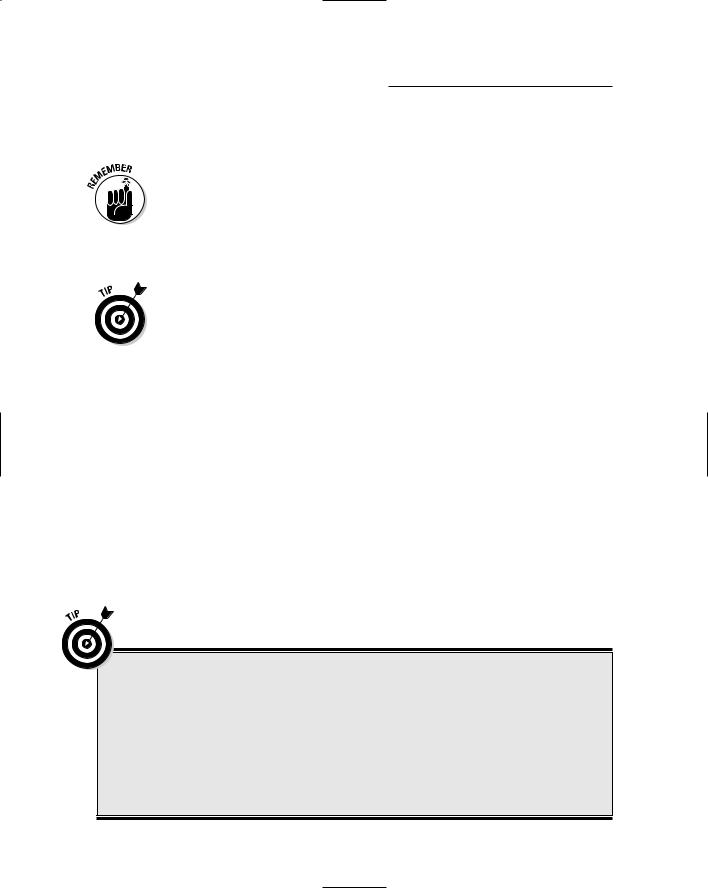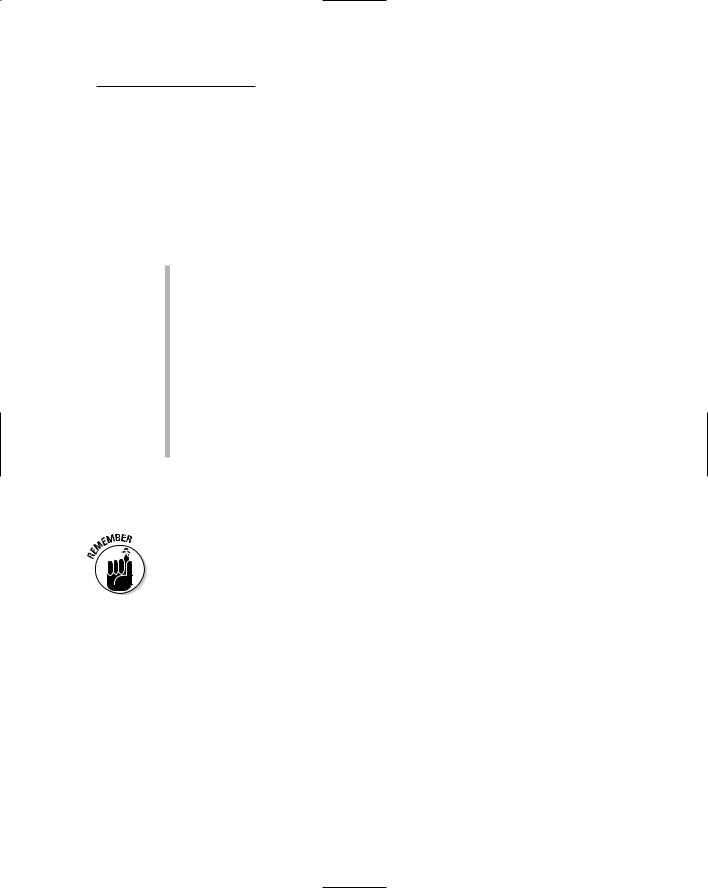
Accounting For Dummies, 4th edition
.pdf
200 Part III: Accounting in Managing a Business
percent higher or lower? The intuitive, knee-jerk reaction answer is yes, profit would have been 10 percent higher or lower. Wouldn’t it? Not necessarily. Margin would have been 10 percent higher or lower — $250,000 higher or lower ($25 margin per unit × 10,000 units = $250,000).
The $250,000 change in margin would carry down to profit unless fixed expenses would have been higher or lower at the different sales volume. The very nature of fixed expenses is that these costs do not change with relatively small changes in sales volume. In all likelihood, fixed expenses would have been virtually the same at a 10 percent higher or lower sales level.
Therefore, profit would have been $250,000 higher or lower. On the base profit of $1.5 million, the $250,000 swing equals a 17 percent shift in profit. Thus, a 10 percent swing in sales volume causes a 17 percent swing in profit. This wider swing in profit is called the operating leverage effect. The idea is that a business makes better use of its fixed expenses when sales go up; its fixed expenses don’t increase with the sales volume increase. Of course, the downside is that fixed expenses don’t decrease when sales volume drops.
Don’t underestimate the impact of small changes in sales price
Recall that in the example the sales price is $100, and revenue-driven variable expenses are 8.5 percent of sales revenue (refer to Figure 9-1). Suppose the business had sold the product for $4 more or less than it did, which is only a 4 percent change — pretty small it would seem. This different sales price would have changed its margin per unit $3.66 net of the corresponding change in the revenue-driven variable expenses per unit. ($4 sales price change × 8.5 percent = $.34 per unit, which netted against the $4 sales price change = $3.66 change in margin per unit.)
Therefore, the business would have earned total margin $366,000 higher or lower than it did at the $100 sales price. ($3.66 change in margin per unit × 100,000 units sales volume = $366,000 shift in margin.) Fixed expenses are not sensitive to sales price changes and would have been the same, so the $366,000 shift in margin would carry down to profit.
The $366,000 swing in profit, compared with the $1.5 million baseline profit in the example, equals a 24 percent swing in profit. A 4 percent change in sales price causes a 24 percent change in profit. Recall that a 10 percent change in sales volume causes just a 17 percent change in profit. When it comes to profit impact, sales price changes dominate sales volume changes.

Chapter 9: Analyzing and Managing Profit 201
The moral of the story is to protect margin per unit above all else. Every dollar of margin per unit that’s lost — due to decreased sales prices, increased product cost, or increases in other variable costs — has a tremendously negative impact on profit. Conversely, if you can increase the margin per unit without hurting sales volume, you reap very large profit benefits.
Know your options for improving profit
Improving profit boils down to three critical factors, listed in order from the most effective to the least effective:
Increasing margin per unit
Increasing sales volume
Reducing fixed expenses
Say you want to improve your profit from the $1.5 million you earned in 2009 to $1.8 million next year, which is a $300,000 or 20 percent increase. Okay, so how are you going to increase profit $300,000? Here are your basic options:
Increase your margin per unit $3, which would raise total margin $300,000 based on the 100,000 units sales volume.
Sell 12,000 additional units at the present margin per unit of $25, which would raise your total margin by $300,000. (12,000 additional units × $25 = $300,000 additional margin.)
Use a combination of these two strategies: Increase both the margin per unit and sales volume such that the combined effect is to improve total margin $300,000.
Reduce fixed expenses $300,000.
The last alternative may not be very realistic. Part of your fixed expenses ($250,000) is the amount allocated from headquarters, over which you have no control. Reducing your direct fixed expenses $300,000, from $750,000 to $450,000, would be drastic and probably would reduce your capacity to make sales and carry out the operations in your part of the business. Perhaps you could do a little belt-tightening in your fixed expenses area, but in all likelihood you would have to turn to the other alternatives for increasing your profit.
The second approach is obvious — you just need to set a sales goal of increasing the number of products sold by 12,000 units. (How you motivate your already overworked sales staff to accomplish that sales volume goal is up to you.) But how do you go about the first approach, increasing the margin per unit by $3?

202 Part III: Accounting in Managing a Business
The simplest way to increase margin per unit by $3 would be to decrease your product cost per unit $3. Or you could attempt to reduce sales commissions from $8.50 per $100 of sales to $5.50 per $100 — which may hurt the motivation of your sales force, of course. Or you could raise the sales price about $3.38 (remember that 8.5 percent comes off the top for sales commission, so only $3 would remain to improve the unit margin). Or you could combine two or more such changes so that your unit margin next year would increase $3.
Closing with a Boozy Example
Several years ago, some friends pooled their capital and opened a liquor store in a rapidly growing area. In their estimation, the business had a lot of promise. They didn’t come to me for advice, but if they had I would have told them one thing to do during their planning stage — in addition to location analysis and competition analysis, of course. I would have recommended that they run some critical numbers through a basic profit model in order to estimate the annual sales revenue they would need to break even. Of course, they want to do better than break even, but the break-even sales level is a key point of reference.
Starting up any business involves making commitments to a lot of fixed expenses. Leases are signed, equipment is purchased, people are hired, and so on. All this puts a heavy fixed cost burden on a new business. The business needs to make sales and generate margin from the sales that is enough to cover its fixed expenses before it can break into the profit column. So, the first step I would have suggested is that they estimate their fixed expenses for the first year. Next, they should have estimated their profit margin on sales. Here there is a slight problem, but one that is not too difficult to deal with.
During their open house for the new store, I noticed the very large number of different beers, wines, and spirits available for sale — to say nothing of the different sizes and types of containers many products come in. Quite literally, the business sells thousands of distinct products. The store also sells many products like soft drinks, ice, corkscrews, and so on. Therefore, the business does not have an easy-to-define sales volume factor (the number of units sold) for analyzing profit. The business example I discuss in this chapter uses a sales volume factor, which is the number of units sold during the period. In the liquor store example, this won’t work. So, a modification is made. Total sales revenue is used for the measure of sales volume, not the number of units (bottles) sold.
The next step, then, is to determine the average margin as a percent of sales revenue. I’d estimate that a liquor store’s average gross margin (sales revenue less cost of goods sold) is about 25 percent. The other variable operating expenses of the liquor store probably run about 5 percent of sales. (I could be off on this estimate, of course.) So, the average margin would be 20 percent of sales (25

Chapter 9: Analyzing and Managing Profit 203
percent gross margin less 5 percent variable operating expenses). Suppose the total fixed operating expenses of the liquor store were about $100,000 per month (for rent, salaries, electricity, and so on), which is $1.2 million per year. So, the store needs $6 million in annual sales to break even:
$1,200,000 annual fixed expenses ÷ 20% average margin = $6,000,000 annual sales revenue to break even
Selling $6 million of product a year means moving a lot of booze. The business needs to sell another $1 million to provide $200,000 of operating earnings (at the 20 percent average margin) — to pay interest expense and income tax and leave enough net income for the owners who invested capital in the business and who expect a decent return on their investment.
I’m not privy to the financial statements of the liquor store. It appears that they have been quite successful. Business seems to be booming, even without my advice. Perhaps they did exactly the sort of profit model analysis that I would have recommended.

204 Part III: Accounting in Managing a Business

Chapter 10
Financial Planning, Budgeting,
and Control
In This Chapter
Defining the benefits of budgeting
Budgeting profit and cash flow
Keeping budgeting in perspective
Staying flexible with budgets
Abusiness can’t open its doors each day without having a pretty good idea of what to expect. And it can’t close its doors at the end of the day
not knowing what happened. Recall the Boy Scouts’ motto: “Be prepared.” A business should follow that dictum: It should plan and be prepared for its future, and it should control its actual performance to reach its financial goals.
Business managers can wait for results to be reported to them on a “look back” basis, and then wing it from there. Or, they can look ahead and carefully plan profit, cash flows, and financial condition of the business, to chart its course into the future. The plan provides invaluable benchmarks; actual results can be compared against the plan to detect when things go off course.
Planning the financial future of a business and comparing actual performance against the plan are the essence of business budgeting. Budgeting is not an end to itself but rather a means or tool of financial planning and control.
But keep in mind that budgeting costs time and money. The business manager should put budgeting to the cost/benefit test. Frankly, budgeting may not earn its keep and could actually cause serious problems that contradict the very reasons for doing it.
Budgeting offers important benefits, but a business may decide not to go to the effort of full-scale budgeting. I can’t argue with a minimal budgeting strategy for some businesses. However, a business should not throw out the budgeting baby with the bathwater. Certain techniques used in budgeting are very useful even when a business doesn’t do formal budgeting.

206 Part III: Accounting in Managing a Business
Exploring the Reasons for Budgeting
The financial statements included in the financial reports of a business are prepared after the fact; they’re based on transactions that have already taken place. (I explain business financial statements in Chapters 4, 5, and 6.) Budgeted financial statements, on the other hand, are prepared before the fact and reflect future transactions that are expected to take place based on the business’s strategy and financial goals. Note: Budgeted financial statements are not shared outside the business; they are strictly for internal management use.
Business budgeting requires setting specific goals and developing the detailed plans necessary to achieve them. Business budgeting should be built on realistic forecasts for the coming period. A business budget is an integrated plan of action — not simply a few trend lines on a financial chart. Budgeting is much more than slap-dashing together a few figures. A budget is an integrated financial plan put down on paper — or, more likely these days, entered in computer spreadsheets. (Many budgeting computer programs are on the market today; ask your CPA or other financial consultant which one he or she thinks is best for your business.)
Business managers don’t just look out the window and come up with budget numbers. Budgeting is not pie-in-the-sky wishful thinking. Business budgeting — to have practical value — must start with a broad-based critical analysis of the most recent actual performance and position of the business by the managers who are responsible for the results. Then the managers decide on specific and concrete goals for the coming year. (Budgets can be done for more than one year, but the first stepping stone into the future is the budget for the coming year — see the sidebar “Taking it one game at a time.”)
In short, budgeting demands a fair amount of managers’ time and energy. Budgets should be worth this time and effort. So why should a business go to the trouble of budgeting? Business managers do budgeting and prepare budgeted financial statements for three main reasons: modeling, planning, and control.
Taking it one game at a time
A company generally prepares one-year budgets, although many businesses also develop budgets for two, three, and five years out. Whenever you reach out beyond a year, what you’re doing becomes more tentative and iffy. Making forecasts and estimates for the next 12 months is tough enough. A one-year budget is
more definite and detailed in comparison to longer-term budgets. As they say in the sports world, a business should take it one game (or year) at a time. Looking down the road beyond one year is a good idea, to set long-term goals and to develop long-term strategy. But long-term planning is different than short-term budgeting.

Chapter 10: Financial Planning, Budgeting, and Control 207
Modeling reasons for budgeting
Business managers should make detailed analyses to determine how to improve the financial performance and condition of their business. The status quo is usually not good enough; business managers are paid to improve things — not to simply rest on their past accomplishments. For this reason managers should develop good models of profit, cash flow, and financial condition for their business. Models are blueprints or schematics of how things work. A financial model is like a roadmap that clearly marks the pathways to profit, cash flow, and financial condition.
Don’t be intimidated by the term model. Simply put, a model consists of variables and how they interact. A variable is a critical factor that, in conjunction with other factors, determines results. A model is analytical, but not all models are mathematical. In fact, none of the financial models in this book is the least bit mathematical — but you do have to look at each factor of the model and how it interacts with one or more other factors. Here’s an example of an accounting model, which is called the accounting equation:
Assets = Liabilities + Owners’ equity
This is a very condensed model of the balance sheet. The accounting equation is not detailed enough for budgeting, however. More detail about assets and liabilities is needed for budgeting purposes.
Chapter 9 presents a profit and loss (P&L) report template for managers (see Figure 9-1). This P&L report is, at its core, a profit model. This model includes the critical variables that drive profit: sales volume, sales price, product cost, and so on. A P&L report, such as the one I show in Figure 9-1, provides the essential feedback information on profit performance of the organizational unit (a profit center in the example). The P&L report also serves as the platform and the point of departure for mapping out the profit strategies and goals for the coming year.
Likewise, business managers need a model for planning cash flow from operating activities. (I explain this important source of cash flow in Chapter 6.) Managers should definitely forecast the amount of cash they will generate during the coming year from making profit. They need a reliable estimate of this source of cash flow in order to plan for other sources of cash flow they will need during the coming year — to provide the money for replacing and expanding the longterm operating (fixed) assets of the business and to make cash distributions from profit to owners. Managers need a model that provides a clear trail of how the sales and expenses of the business drive its assets and liabilities, which in turn drive the cash flow from operating activities.

208 Part III: Accounting in Managing a Business
Most business managers see the advantages of budgeting profit for the coming year; you don’t have to twist their arms to do this. At the same time, many businesses balk at budgeting changes in assets and liabilities during the coming year, which means they can’t budget cash flow from operating activities. All their budget effort is focused on profit, and they leave cash flows and financial condition in the dark. This is a dangerous strategy when the business is in a tight cash position. The business should not simply assume that its cash flow from operating activities will be adequate to its needs during the coming year.
The best advice is to prepare all three budgeted financial statements:
Budgeted income statement (profit report): The P&L report shown in Figure 9-1 serves as a hands-on profit model — one that highlights the critical variables that drive profit. This P&L report separates variable and fixed expenses and includes sales volume, margin per unit, and other factors that determine profit performance. The P&L report is a schematic that shows the path to operating profit. It reveals the factors that must be improved in order to improve profit performance in the coming period.
Budgeted balance sheet: The key connections and ratios between sales revenue and expenses and their corresponding assets and liabilities are the elements in the model for the budgeted balance sheet. These vital connections are explained throughout Chapters 4 and 5. The budgeted changes in operating assets and liabilities provide the information needed for budgeting cash flows during the coming year.
Budgeted statement of cash flows: The budgeted changes during the coming year in the assets and liabilities used in making profit (conducting operating activities) determine cash flow from operating activities for the coming year (see Chapter 6). In contrast, the cash flows of investing and financing activities depend on the managers’ strategic decisions regarding capital expenditures that will be made during the coming year, how much new capital will be raised from debt and from owners’ sources of capital, and the business’s policy regarding cash distributions from profit.
In short, budgeting requires good working models of making profit, financial condition (assets and liabilities), and cash flow. Budgeting provides a strong incentive for business managers to develop financial models that help them make strategic decisions and exercise control — and do better planning.
Planning reasons for budgeting
One main purpose of budgeting is to force managers to create a definite and detailed financial plan for the coming period. To construct a budget, managers have to establish explicit financial objectives for the coming year and identify exactly what has to be done to accomplish these financial objectives.

Chapter 10: Financial Planning, Budgeting, and Control 209
Budgeted financial statements and their supporting schedules provide clear destination points — the financial flight plan for a business.
The process of putting together a budget directs attention to the specific things that you must do to achieve your profit objectives and optimize your assets and capital. Basically, budgets are a form of planning that push managers to answer the question “How are we going to get there from here?”
Budgeting can also yield other important planning-related benefits:
Budgeting encourages a business to articulate its vision, strategy, and goals. A business needs a clearly stated strategy guided by an overarching vision, and it should have definite and explicit goals. It is not enough for business managers to have strategies and goals in their heads. Developing budgeted financial statements forces managers to be explicit and definite about the objectives of the business, as well as to formulate realistic plans for achieving the business objectives.
Budgeting imposes discipline and deadlines on the planning process.
Busy managers have trouble finding enough time for lunch, let alone planning for the upcoming financial period. Budgeting pushes managers to set aside time to prepare a detailed plan that serves as a road map for the business. Good planning results in a concrete course of action that details how a company plans to achieve its financial objectives.
Management control reasons for budgeting
I deliberately put this reason last, after the modeling and planning reasons for budgeting. Many people have the mistaken notion that the main purpose of budgeting is to rein in managers and employees, who otherwise would spend money like drunken sailors. Budgeting should not put the business’s managers in a financial straitjacket. Tying the hands of managers is not the purpose of budgeting. Having said this, however, it’s true that budgets serve a management control function. Management control, first and foremost, means achieving the financial goals and objectives of the business, which requires comparing actual performance against benchmarks and holding individual managers responsible for keeping the business on schedule in reaching its financial objectives.
The board of directors of a corporation focuses its attention on the master budget for the whole business: the budgeted income statement, balance sheet, and cash flow statement for the business as a whole for the coming year. The chief executive officer (CEO) of the business focuses on the master budget as well, but the CEO must also look at how each manager in the organization is doing on his or her part of the master budget. As you move down the organization chart of a business, managers have narrower responsibilities — say, for the business’s northeastern territory or for one major product line. A
